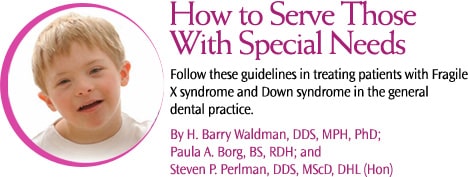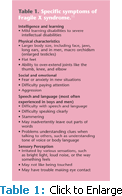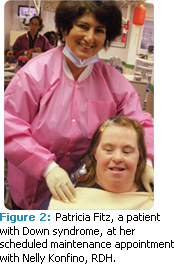
How to Serve Those With Special Needs
Follow these guidelines in treating patients with Fragile X syndrome and Down syndrome in general dental practice.
This course was published in the October 2010 issue and expires October 31, 2013. The authors have no commercial conflicts of interest to disclose. This 2 credit hour self-study activity is electronically mediated.
EDUCATIONAL OBJECTIVES
After reading this course, the participant should be able to:
- Discuss the prevalence of disability in the United States.
- Understand the causes and clinical symptoms of Fragile X syndrome and Down syndrome.
- List the clinical dental features associated with Down syndrome.
- Provide strategies for effectively providing oral health care to people with Fragile X syndrome and Down syndrome.
- Recognize the need for oral health care professionals to provide services for individuals with special needs.
Currently, people with disabilities are dependent on community health care providers for all of their health care services, including care from dentists and dental hygienists. Health care providers are much better able to serve this population if they are knowledgeable about a patient’s particular disability.
According to the National Survey of Children with Special Health Care Needs, oral health care is one of the most needed services by children with special health care needs, but it is the least accessible.1 The Commission on Dental Accreditation in the Standards for Dental Hygiene Education Programs has recognized the need to prepare dental hygiene program graduates for the care of individuals with special needs and asserts that graduates should be well-versed in determining the treatment needs of patients who have special needs.2 Changes are being made in the curriculum for the next generation of dental hygienists. But dental professionals in private practice must also be prepared to treat the increasing numbers of individuals with special needs.
INTELLECTUAL DISABILITIES
People with intellectual disabilities are society’s most medically neglected population. Nearly 300 million people—3% of the world’s population—have an intellectual disability.3 Approximately 51.2 million Americans reported they had a disability in the 2005 census with 32.5 million reporting their disability as severe.4 In children aged 6 years to 14 years, 4 million or 11% have a disability, including more than 1 million with learning and intellectual disabilities.4 Among children younger than 15 years, boys are more likely than girls to have a disability (11% vs 6%).4 The chances of developing a disability rise with age; 72% of people 80 years and older have a disability.5 More than 5 million individuals 15 years and older have a learning or intellectual disability.6 Fragile X syndrome and Down syndrome are among the most widely documented genetic conditions that affect intellectual ability.
FRAGILE X SYNDROME
 Fragile X syndrome (FXS) is a trinucleotide repeat disorder caused by a change in the FMR1 gene. Some inherited diseases, such as cystic fibrosis and Huntington’s disease, are caused by one change in the genetic code. Fragile X syndrome, however, is caused by the multiplication of information in the genetic code.10 A small section of the gene code is repeated on the fragile bottom area of the X chromosome. The more repeats in the gene code, the more likely a problem will arise. The FMR1 gene makes a protein needed for typical brain development. When a defect is present in this gene, too little or none of the protein is produced.
Fragile X syndrome (FXS) is a trinucleotide repeat disorder caused by a change in the FMR1 gene. Some inherited diseases, such as cystic fibrosis and Huntington’s disease, are caused by one change in the genetic code. Fragile X syndrome, however, is caused by the multiplication of information in the genetic code.10 A small section of the gene code is repeated on the fragile bottom area of the X chromosome. The more repeats in the gene code, the more likely a problem will arise. The FMR1 gene makes a protein needed for typical brain development. When a defect is present in this gene, too little or none of the protein is produced.
Both men and women can be affected. However, because men have only one X chromosome, a fragile X is likely to affect them more severely.7 Men pass this mutation on only to their daughters. Their sons receive a Y chromosome, which does not include the FMR1 gene. FXS occurs in approximately 1 in 4,000 men and 1 in 8,000 women.8 It is the most common form of inherited intellectual disability in men, and a significant cause of intellectual disability in women.
The defect in the FMR1 gene results in in the abnormal communication of brain cells, and it triggers a form of hyperactive brain activity, which is common in many autism spectrum disorders. Approximately 2% to 6% of diagnosed cases of autism are caused by the fragile X gene and about one-third of children who have FXS also have an autism spectrum disorder.9
SYMPTOMS OF FXS
Not all individuals with FXS exhibit the same symptoms. The syndrome has a wide range of signs and they are often milder in women than in men.10 Symptoms of FXS may have effects on the following: intelligence and learning ability, physical characteristics, social and emotional abilities, speech and language, and sensory perceptions. Table 1 provides specific symptoms for each category.11
DOWN SYNDROME
Down syndrome (DS) is a set of intellectual and physical symptoms that result from the presence of an extra copy of chromosome 21 (called trisomy 21), which affects brain and body development (Figure 1). More than 350,000 people living in the United States have DS. Approximately 5,000 children are born each year with DS.12 The condition is not related to race, nationality, or socioeconomic status, but its risk increases with maternal age. It occurs in one of 100 births among women older than age 40. Advances in medical treatments have significantly improved the quality and length of life in those with DS, who now live in the community as opposed to being placed in institutions.13,14
Not long ago, the average life expectancy of individuals with DS was less than 20 years, but the majority now live past the age of 55.14 In the United States, the median age of death in people with DS has increased from 2 years in 1968 to more than 50 years for whites and 25 years for blacks.14
Symptoms of DS can range from mild to severe. The range of IQ levels among people with DS can be just below aver age to profoundly affected. Language and motor development may be delayed or slow.13
Patients with DS are predisposed to serious comorbidities including congenital heart disease, auditory and visual abnormalities, congenital gastrointestinal defects that could result in bowel obstruction, and skeletal malformations. They also are prone to celiac disease, leukemia, thyroid dysfunction, and premature dementia, which may begin as early as 40 years of age. Moreover, these patients are often obese and have an abnormal immune system with increased incidence of lower respiratory tract infections and pulmonary secretions.
SYMPTOMS OF DOWN SYNDROME
Children with DS are clinically recognized by the finding of a “flat face.” They may also have an upward slant to the eyes, a short neck, abnormally shaped ears, and white spots on the iris of the eye. They typically have small hands and feet, with a deep crease in the palm of the hand, and poor muscle tone. They also have a small nasal airway, thus, chronic mouth breathing is common, which leads to xerostomia and tongue and lip fissures.
TABLE 2. CLINICAL DENTAL FEATURES ASSOCIATED WITH DOWN SYNDROME.
- A greater incidence of congenitally missing teeth
- An increased susceptibility to periodontal conditions because of a compromised immune system and other factors17
- Lower incidence of dental caries possibly due to a supervised or institutionalized diet and delayed eruption of and increased spacing between teeth17
- A greater incidence of open bite and cross bite
- Shortened root lengths
- Delayed eruption of teeth (on average 16 months for boys and 11 months for girls)
- Anomalies in the form and number of teeth
- Smaller mesial-distal width of some permanent teeth
- Protruding tongue
- Tongue that may appear too large because the oral cavity is smaller in size due to a low and narrow palate and underdevelopment of the midface
People with DS frequently exhibit specific symptoms related to the oral cavity, which are detailed in Table 2. Children and adults with DS have multiple predisposing factors for developing obstructive sleep apnea. This is primarily due to their unique facial and upper airway features that include midfacial and mandibular hypoplasia, an abnormally small hypo pharynx, encroaching tonsils and adenoids, and generalized pharyngeal mus clehypotonia with collapse of the upper airway during sleep.
Obstructive sleep apnea results in frequent sleep arousals, and is associated with snoring and daytime drowsiness. Cooperative efforts between physicians and dental professionals can help people with DS who also have sleep apnea through the use of oral appliances that reposition the lower jaw and tongue to keep the pharyngeal airway open, and continuous positive airway pressure (CPAP) breathing by using a tight, sealed facial mask.15-17 However, the acceptance of the CPAP is dependent on the intellectual capacity of the individual with DS.
PROVIDING CARE TO PATIENTS WITH FRAGILE X SYNDROME AND DOWN SYNDROME
The oral health needs of both adults and children with FXS and DS are similar to those of the general public and they can be treated in the traditional dental practice (Figure 2). Individual patient needs should serve as the basis of the dental hygiene process of care. It is critical to consider the individual’s family, culture, language, and quality of life when planning treatment, in addition to the patient’s level of intellectual disability, and social, emotional, and sensory perception abilities.
A detailed review of the patient’s medical and dental histories with family members is critical in the case planning process. In addition, the legal guardianship of the patient must be documented and informed consent must be secured for all treatment that is provided.
Effective communication is important to the development of a cooperative relationship with the patient. The patient’s family or caregiver should be able to provide valuable insight, but it is important for the dental hygienist to communicate directly with the patient. Dental appointments and a regimen of self-care will be much more successful if the patient’s cooperation is achieved. Visual aids may help dental hygienists explain important oral health care concepts to patients with FXS or DS. Also determining what motivates a patient through communication with family or caregiver can help ensure a smooth appointment process when this motivating factor is offered at the end of the appointment.18
Scheduling appointments early in the day is beneficial because both the patient and the dental hygienist are more rested. Appointments should be kept brief. Oral health care for patients with FXS or DS should begin at a young age so a relationship can be cultivated with the patient, and positive oral health habits can be encouraged from the start.18
CONCLUSION
Individuals with FXS, DS, or other intellectual disabilities are members of our communities and dependent on local dental practices for needed care. They are also traditionally underserved when it comes to oral health care. With some preparation and education, dental professionals can provide effective and necessary oral health care to people with intellectual disabilities—ensuring access to care for a significant portion of the population.
REFERENCES
- The National Survey of Children with Special Health Care Needs Chartbook 2005-2006. Rockville, Md: Department of Health and Human Services; 2007.
- Commission on Dental Accreditation. Accreditation Standards for Dental Hygiene Education Programs Standard. Patient care competencies: 2-16. Available at: www.ada.org/sections/educationAndCareers/pdfs/dh.pdf. Accessed September 10, 2010.
- Special Olympics. A world of neglect. Available at: www.specialolympics.org/SlideShow.aspx?id=5810&terms=a+world+of+neglect. Accessed September 10, 2010.
- US Census Bureau. Prevalence of disability among children under 15 years old by specific measures of disability, 2005. Available at: www.census.gov/hhes/www/disability/sipp/disab05/d05tb4.pdf Accessed September 10, 2010.
- US Census Bureau News: Facts by features: Americans with Disabilities Act: July 28. Available at: www.census.gov/newsroom/releases/archives/facts_for_features_special_editions/cb10-ff13.html. Accessed September 20, 2010.
- US Census Bureau. Prevalence of disability among individuals 15 years and older by specific measures of disability, 2005. Available at: www.census.gov/hhes/www/disability/sipp/disab05/d05tb4.pdf. Accessed September 10, 2010.
- Fragile X syndrome. Available at: www.nlm.nih.gov/medlineplus/ency/article/001668.htm. Accessed September 10, 2010.
- Genetics Home Reference. Fragile X syndrome. Available at: http://ghr.nlm.nih.gov/condition/fragile-x-syndrome. Accessed September 10, 2010.
- The National Fragile X Foundation. Autism and Fragile X syndrome. Available at: www.nfxf.org/html/autism_and_fragile_x_syndrome.htm. Accessed September 10, 2010.
- Fraxa Research Foundation. Finding a cure for Fragile X. Available at: www.fraxa.org/ research_summaryFindings.aspx. Accessed September 10, 2010.
- Eunice Kennedy Shriver National Institute of Child Health and Human Development. Fragile X syndrome. Available at: www.nichd.nih.gov/health/topics/fragile_x_syndrome.cfm Accessed September 10, 2010.
- Eunice Kennedy Shriver National Institute of Child Health and Human Development. Down syndrome. Available at: www.nichd.nih.gov/health/topics/Down_Syndrome.cfm. Accessed September 10, 2010.
- National Down Syndrome Congress. Facts about Down syndrome. Available at: www.ndsccenter.org/resources/package3.php. Accessed September 10, 2010.
- Bittles AH, Glasson EJ. Clinical, social, and ethical implications of changing life expectancy in Down syndrome. Dev Med Child Neurol. 2004;46:282-286.
- Marcus CL, Keens TG, Bautista DB, von Pechmann WS, Ward SL. Obstructive sleep apnea in children with Down syndrome. Pediatrics. 1991;88:132-139.
- Kribbs NB, Pack AI, Kline LR, et al. Objective measurement of patterns of nasal CPAP use by patients with obstructive apnea. Am Rev Resp Dis. 1993;147:887-895.
- Waldman HB, Hasan FM, Perlman SP. Down syndrome and sleep-disordered breathing: the dentist’s role. J Am Dent Assoc. 2009;140:307-312.
- Pilcher E. Dental care for the patient with Down syndrome. Available at: www.down-syndrome.org/reviews/84. Accessed September 10, 2010.
From Dimensions of Dental Hygiene. October 2010; 8(10): 66, 69-71.



